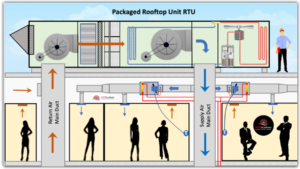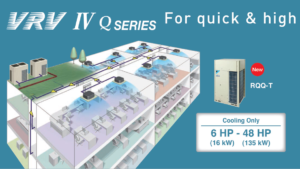VAV (Variable Air Volume) and VRV (Variable Refrigerant Volume) systems, while both used for climate control in buildings, take fundamentally different approaches. Here’s a detailed breakdown of their variations:
Function:
-
VAV (Variable Air Volume): This system focuses on managing the airflow rate of conditioned air throughout a building. It maintains a constant air temperature but adjusts the volume delivered to different zones based on their cooling or heating needs. Imagine a central air conditioner supplying cool air to various rooms. VAV systems use dampers to regulate how much of this cool air reaches each area.

-
VRV (Variable Refrigerant Volume): VRV systems, on the other hand, concentrate on regulating the refrigerant flow to control temperature. They use refrigerant, a substance that absorbs and releases heat, to cool or heat indoor spaces. VRV systems vary the amount of refrigerant delivered to individual indoor units, allowing for independent temperature control in different zones. Think of it as having separate mini air conditioners for each area, with a central system managing the refrigerant flow to each unit.

Components:
-
VAV System:
- Air Handling Unit (AHU): Conditions air (heating, cooling, dehumidifying) and supplies it to the building.
- Ductwork: A network of pipes that distributes conditioned air throughout the building.
- Variable Air Volume (VAV) Boxes: These are located at the entry points of conditioned air to individual zones. They contain dampers that adjust airflow based on zone temperature needs.
- Control System: Monitors and regulates the entire system, including temperature sensors in each zone and controls for the AHU and VAV boxes.
-
VRV System:
- Outdoor Unit: Houses the compressor, condenser, and expansion valve, which manage the refrigerant circulation.
- Refrigerant Piping: Carries the refrigerant to indoor units.
- Indoor Units: These are located in each zone and handle air conditioning or heating using the supplied refrigerant. They can be various types like wall-mounted units, cassettes for ceilings, or ducted units for concealed installation.
- Control System: Similar to VAV systems, it monitors and regulates the entire system, including temperature sensors in each zone and controls for the outdoor unit and indoor units.
Key Differences:
1. Medium Used:
- VAV: Relies on conditioned air for temperature control.
- VRV: Utilizes refrigerant for temperature control.
2. Ductwork:
- VAV: Requires an extensive network of ductwork to distribute conditioned air.
- VRV: Uses refrigerant piping instead of bulky ductwork, offering more flexibility in installation.
3. Zoned Temperature Control:
- VAV: Can provide zoned temperature control, but the complexity depends on the system design and damper configuration.
- VRV: Offers excellent zoned temperature control as each indoor unit can be individually regulated.
4. Energy Efficiency:
- VAV: Can be energy-efficient if properly managed. Leaks in ductwork can waste conditioned air, reducing efficiency.
- VRV: Generally more energy-efficient due to inverter technology that adjusts refrigerant flow based on demand, reducing unnecessary energy consumption.
5. Installation and Maintenance:
- VAV: Complex installation due to ductwork and control systems. Maintenance requires skilled technicians to handle the AHU, VAV boxes, and control systems.
- VRV: Less complex than VAV due to the absence of ductwork. However, it still requires specialized technicians for installation and maintenance of the outdoor unit, refrigerant piping, and indoor units.
6. Initial Cost:
- VAV: Generally has a lower initial cost due to simpler components compared to VRV. However, adding complex zoning controls can increase the cost.
- VRV: Typically has a higher initial cost due to the advanced technology and use of refrigerant piping.
Choosing Between VAV and VRV:
-
Consider VAV if:
- Your building has dedicated zones requiring different temperatures (e.g., server rooms vs. offices).
- You have an existing building with ductwork already in place.
- You have a budget-conscious project where a lower initial investment is a priority.
-
Consider VRV if:
- Your building has an open floor plan or diverse temperature needs across zones.
- You’re planning a new construction or renovation without existing ductwork.
- Your project prioritizes energy efficiency and long-term cost savings despite a potentially higher upfront investment.
Conclusion:
Both VAV and VRV systems have their pros and cons. The best choice hinges on your specific building’s requirements, budget, and desired level of temperature control. Consulting with an HVAC professional is highly recommended.
Looking to install a commercial HVAC System or Duct work in your Business Area?
Contact Vipul Ac to learn about our HVAC Service
Call +91 9825636606 Today.
